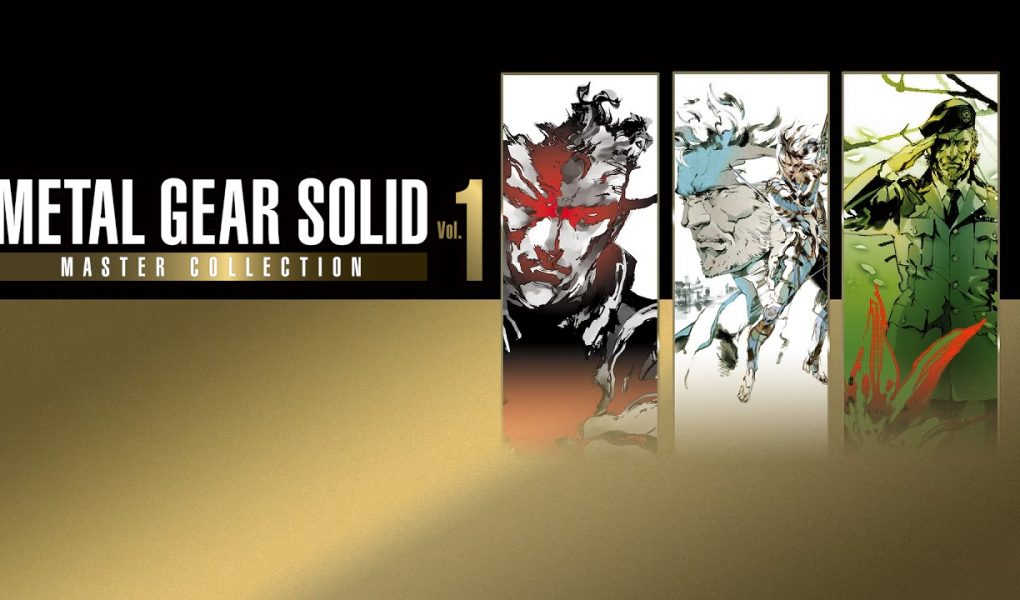METAL GEAR SOLID: MASTER COLLECTION Vol.1 brings the iconic stealth espionage action games to modern consoles, and today we will be taking a quick look at each of the included games (and bonuses) to see what this collection has to offer.
As a reminder METAL GEAR SOLID: MASTER COLLECTION Vol.1 is a collection of games that were originally released onto the MSX, PlayStation, and PlayStation 2, and have been ported to modern consoles. The collection itself was released in October 2023 physically and digitally onto the Nintendo Switch, PlayStation 5, and Xbox Series X|S (as well as digitally onto PlayStation 4 and Windows PC), but then in March 2024 the PlayStation 4 version received a physical release. This physical PlayStation 4 release was possibly due to demand from fans, as Metal Gear Solid did debut on PlayStation platforms, and it includes a free digital upgrade to the PlayStation 5 version of the game (the PS4 disc needs to be in the console in order to play). So, with that out of the way. What exactly does this METAL GEAR SOLID: MASTER COLLECTION Vol.1 contain?
As shown in the infrographic above MASTER COLLECTION Vol.1 contains the Metal Gear Solid trilogy, the MSX originals and the Famicom/NES versions of Metal Gear and Snake’s Revenge. In addition it also contains Master Book and Screenplay Books for each game, as well as Graphic Novels and Digital Soundtrack.
Now, this is where things start to get interesting, as instead of installing as a single game application the collection is actually installed (and played) as separate games. For instance; Metal Gear Solid, Metal Gear Solid 2: Sons of Liberty, and Metal Gear Solid 3: Snake Eater will be installed as individual games. Metal Gear & Metal Gear 2: Solid Snake on the other hand are bundled together and installed as a single game. Each of these games also contain the Master Book and Screenplay book related to them, with Metal Gear Solid also including the VR Missions, Special Missions and Integral games (which were originally sold as separate games on the PlayStation).
The remaining content meanwhile, listed in the infrographic as Bonus Content, also installs as a separate game application and contains the Famicom/NES games, Videos of Graphic Novels and the Digital Soundtrack for all of the games.
As such, METAL GEAR SOLID: MASTER COLLECTION Vol.1 contains the following content:
Games:
Metal Gear Solid
Metal Gear Solid
Metal Gear Solid VR Missions
Metal Gear Solid Special Missions
Metal Gear Solid Integral
Metal Gear Solid 2: Sons of Liberty
Metal Gear Solid 3: Snake Eater
Metal Gear
Metal Gear 2: Solid Snake
Metal Gear
Snakes Revenge
Books:
Metal Gear Solid
Master Book
Screenplay Book
Metal Gear Solid 2: Sons of Liberty
Master Book
Screenplay Book
Metal Gear Solid 3: Snake Eater
Master Book
Screenplay Book
Metal Gear & Metal Gear 2 Solid Snake
Master Book
Screenplay Book
Videos:
Metal Gear Solid: Digital Graphic Novel
Metal Gear Solid 2: Digital Graphic Novel
Music:
Metal Gear Solid Soundtrack Collection
Now, it might be strange for the games and bonus content to be split into separate game applications, but each of the games can be purchased individually from digital storefronts. So instead of creating a complete package interface for the disc version of the game, it is simply the individual game packages placed onto a disc (or bundled together for a digital download).
While this may not look particularly great, as it does clutter up your dashboard, it does mean that you can choose which games to have installed at any one time. Which is a nice option to have, as these games can be quite the time sink and storage is valuable. It is worth noting that the Bonus Content is only included with the MASTER COLLECTION Vol.1 and can not be purchased separately.
Metal Gear Solid:
Released in 1998 for the PlayStation, Metal Gear Solid revolutionized the concept of stealth action game with its cinematic presentation, 3D visuals and tactical gameplay that saw snake infiltrate Shadow Moses. Even now, some 26 years later, the game still manages to deliver an exceptional experience, that is if you can ignore the wavey polgyon visuals. The importance of Metal Gear Solid being available on modern consoles is huge, as other than a PlayStation Classics release (for PS3, PSP and PS1 Classics Console), it has never received an updated port until now.
I believe the previous PlayStation Classic releases of Metal Gear Solid were just the original PS1 game being emulated, where as this MASTER COLLECTION release of the game seems to have undergone some changes. On the surface it is hard to tell what, as the game looks as it did before with its 4:3 aspect ratio (which can be changed to 16:9), but presented in HD. The game pretty much plays as you’d expect, but the frame-rate does occasionally seem inconsistent and not as smooth as I remember when playing the PlayStation Classics release.
Overlooking any potential performance issues, and the fact it uses a different version of the game to what Europeans might remember (Johnny isn’t naked in the cells and instead wears boxers), this version of Metal Gear Solid is undeniably the best variation available. Why exactly? Well not only does it feature EU, US and Japanese language versions of Metal Gear Solid, albeit Japanese language version requires an additional download (same goes for all games), but it also includes VR Missions, Special Missions and Integral. All of which were released as separate discs in those regions.
Being able to experience the original Metal Gear Solid with trophy/achievement support in HD is one thing, but being able to experience Integral (released only in Japan) as well as the VR Missions and Special Missions in HD is another. It’s the complete Metal Gear Solid package, in a single game, and one that further cements this fact with the inclusion of Screenplay and Master Books. These Digital Only books, of which are accessible from the main menu, not only provide additional hours of content but provide you with further insights into the world of Metal Gear Solid. The screenplay book especially, as you might see conversations that you never knew existed.
Metal Gear Solid 2: Sons of Liberty
Released in 2001 for the PlayStation 2, Metal Gear Solid 2: Sons of Liberty brought the tactical espionage action to (at the time) next-generation of console hardware, and brought about many changes, some of which divide fans until this day. This second game in the “Solid” Metal Gear saga made many improvements to the classic formula, with updated cinematic sequences, music from Harry Gregson-Williams, and new control options including a (much needed) first-person shooting perspective.
Of course the biggest change, thus dividing fans opinion of the game, was introducing an entirely new character that was controlled for a large portion of the game. For those unfamiliar Metal Gear Solid 2: Sons of Liberty takes place several years after the Shadow Moses incident, and is split into two distinctive acts. The Tanker and Big Shell, with Tanker seeing players control Snake and the Big Shell seeing Raiden introduced as the protagonist. On the surface it seems like a strange decision, but as you play through the story you soon begin to realize (hopefully) what is actually happening and it delivers some exceptional pieces of storytelling.
Story line aside, don’t forget to bring the snacks, this modern-day version of the game is actually based upon the HD Collection version that was released onto the PlayStation 3, and the same applies to Metal Gear Solid 3: Snake Eater and the MSX games. I wasn’t aware of this, despite it being mentioned before, and so I was disappointed to find out, as it feels like the game is merely being emulated rather than ported to the relevant platform. As soon as the game starts you’ll briefly see the “HD Collection” logo, and if the game takes awhile to load (which did happen for me) then you’ll see it again.
Despite the occasional long loading times, and possibility of crashing (it did for me while recording gameplay), this version of Metal Gear Solid 2: Sons of Liberty stood out to me. The performance and visuals stand-out more so than Metal Gear Solid 3: Snake Eater, and feels like a refind, more polished, experience. This combined with the relevant Screenplay and Master Book, which once again offer more insights into the world of this game, also provide a complete Metal Gear Solid 2 package within a single game.
Metal Gear Solid 3: Snake Eater
Released in 2004 for the PlayStation 2, Metal Gear Solid 3: Snake Eater takes the “Solid” Metal Gear saga into a completely new direction, with it set before the events of the MSX Metal Gear games and puts players in control of Naked Snake. Once again music is provided by Harry Gregson-Williams and sees cinematic set pieces mixed with tactical espionage action, except this time the gameplay is slightly different.
As Metal Gear Solid 3: Snake Eater takes place in the 1960s, and around the time of the Cold War, the technological equipment in the other games is non-existent (so to speak). As such players have to choose what type of radar and cameo to wear based on the surrounding environment. Additionally this game introduced players to a more prominent stamina bar and a robust recovery system in which Naked Snake will need to eat food to keep healthy and use various recovery items (bandages, splints, blood packs) in order to recovery health effectively.
Personally I’ve never enjoyed Snake Eater, especially with Sons of Liberty leaving so many unanswered questions, and even twenty years later I’m still pretty bad at the game (just look at the gameplay video below for proof). That being said it still delivered an interesting story and expanded the ‘Metal Gear’ universe in ways we could not have expected. Compared to the other games it feels like an entirely different type of Metal Gear Solid experience and keeps the franchise fresh and alive.
This modern-day version of the game once again is based upon the HD Collection that was previously released onto the PS3 and Xbox 360 all those years ago, and unlike Sons of Liberty the gameplay and visuals do not feel that improved. Sons of Liberty’s port feels upscaled, polished and improved but Snake Eater still feels washed out and overly green. This is possibly intentional, due to the fact the game takes place in a jungle, but considering they are from the same console generation and would have possibly received the same HD treatment it is interesting how different they look and feel.
As with Metal Gear Solid and Metal Gear Solid 2: Sons of Liberty this modern-day version of Metal Gear Solid 3: Snake Eater includes a Master Book and Screenplay book with both offering more insights and codec conversations for players to enjoy. As with the previous books they are an insightful read, and can easily be navigated, especially the Screenplay book which provides a script for all of the codec calls within the game.
Metal Gear & Metal Gear 2: Solid Snake
Metal Gear (1987) and Metal Gear 2: Solid Snake (1990) were the games that brought the famous Snake and Hideo Kojima into the spotlight with each game offering players a unique approach to story-telling and stealth gameplay. Both games are included in the MASTER COLLECTION Vol.1 (but are also included with the individual digital purchase of Metal Gear Solid), and presented in 4:3 aspect ratio. Bizarrely despite owning these previously in the HD Collection, which these games are based off for this modern-day-release, I’ve never actually played them until now and I wish I played them sooner.
Metal Gear is obviously the starting point, the beginning of the epic journey, and sees Snake infiltrate Outer Heaven to destroy the weapon known as Metal Gear. It’s a top-down stealth adventure where players will need to navigate the labyrinth-like maps, which see enemies refresh on each screen, in order to rescue hostages, find key items, and locate the Metal Gear weapon. Interestingly despite its age the game holds up really well and thanks to the HD presentation it offers crystal clear pixel visuals.
Metal Gear 2: Solid Snake on the other hand is the second game and sees Solid Snake infiltrate Zanzibar in order to locate a new Metal Gear weapon. Metal Gear 2: Solid Snake is a vast improvement on the original, with updated codec conversations, improved stealth gameplay, digital radar tracking and more. It’s these elements that became fundamental in years to come within Metal Gear Solid, so it’s interesting going back and seeing where they original came from. Metal Gear 2: Solid Snake is also worth playing as it adds context to some conversations that happen in Metal Gear Solid with Gray Fox and Campbell.
Realistically Metal Gear & Metal Gear 2: Solid Snake can be seen as side dishes to the main course, but they are included and come with their own achievement/trophy lists and their own set of challenges. As with other games in this collection the Master Book and Screenplay books are included, but they do not offer as much content as the other games (which is to be expected considering their size).
Bonus Content
Exclusive to the Master Collection Vol.1 bundle (or physical release) the Bonus Content adds SNES/Famicom versions of Metal Gear (1987) and Snake’s Revenge (1990), Digital Graphic Novels for Metal Gear Solid and Metal Gear Solid 2 as well as a Digital Soundtrack. Sadly the Digital Graphic Novels are videos that have to be downloaded separately (via the application) with them tallying up to 20GB. Additionally the Digital Soundtrack doesn’t seem to offer the full song list and instead only features highlights from each of the respective games.
That’s not exactly impressive considering this is meant to be the Master Collection, and the SNES/Famicom games aren’t partically great either. Of course these are HD versions of classic games, and presumably ported from the HD Collection releases as with the other games, but they do not feature any achievements/trophies and the games themselves are over within a matter of minutes (if not seconds) due to them being more action-shooters rather than stealth games. It is nice that they are included, but this portion of the bundle feels like it should offer something more (or at least be downloaded as a package without any additional downloads).
Final Thoughts:
Overall the METAL GEAR SOLID: MASTER COLLECTION Vol.1 is a collection that brings the best of the original Metal Gear Solid Trilogy, and relevant MSX games, into a single collection and offers hours of gameplay, intense replay-ability, and lots to explore. For newcomers the game should still be accessible, while to long time fans it offers nostalgia in a modern era.
Majority of the content included in this collection we’ve seen before, and isn’t much different from the HD Collection previously released for PS3/Xbox 360 (excluding Metal Gear Solid of course), but the addition of Digital Graphic Novels, Soundtrack and Books provide an extensive amount of content that shouldn’t be ignored. Whether you like just one game, or all of them, the METAL GEAR SOLID: MASTER COLLECTION Vol.1 is certainly worth exploring.
METAL GEAR SOLID: MASTER COLLECTION COLLECTION Vol.1 is available digitally and physically for the Nintendo Switch, PlayStation 4, PlayStation 5, Xbox Series X|S, as well as digitally on Windows PC via Steam. Further details about this collection are available through the official website.
Disclosure: I received a free review copy of this product from keymailer. #MGSVol1




